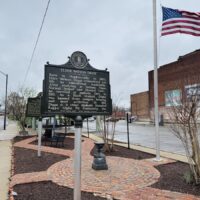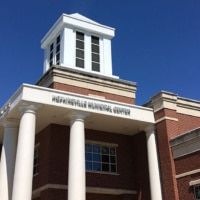Henry Wahl worked at the Louis Bossert sash and blind factory in Brooklyn, New York, for his entire adult life. Stepping off the boat in 1871, the 17-year-old immigrant quickly found work as a carpenter at the factory. As his skills developed, he became a joiner, constructing window sash and Venetian blinds.
By age 57, he was superintendent of the factory. He also died that year of Bright’s disease. Henry Wahl was my second great-grandfather, and this is my ancestral window story.
One month after Henry Wahl’s death and nearly 1,000 miles away, Thomas Monroe Dalton bought an empty lot on East Seventh Street in Hopkinsville, Kentucky, on which he would build the home in which we now live.
Sash factories
In big cities like Brooklyn and Nashville, windows were made in factories by the late 1800s. But don’t let the word factory fool you. The process was still mostly done by hand. The wooden pieces were joined together with mortises, tenons and pegs by a skilled carpenter called a joiner who specialized in these kinds of fittings. No iron nails used here!
Many people today consider Hopkinsville a small town. But the Hopkinsville of 1900 was a thriving small city and was steadily growing. Between 1890 and 1910, the population grew by 38%. There was a real need for new buildings and infrastructure. Hopkinsville’s building scene was dominated by two heavy hitters: the Dalton Bros. and Forbes & Bro.
And by 1906, Forbes & Bro. had a sash factory.

The Forbes brothers
The Forbes and Dalton brothers are a fascinating study in parallels. If you’ve been following this column, you’re familiar with three of the four Dalton brothers: George, Monroe, and Hilliard.
The only brother we haven’t met is Garner, the baby.
All four played a part in the family business.
The Forbes brothers were James and Madison Forbes, later joined by Madison’s son, William.
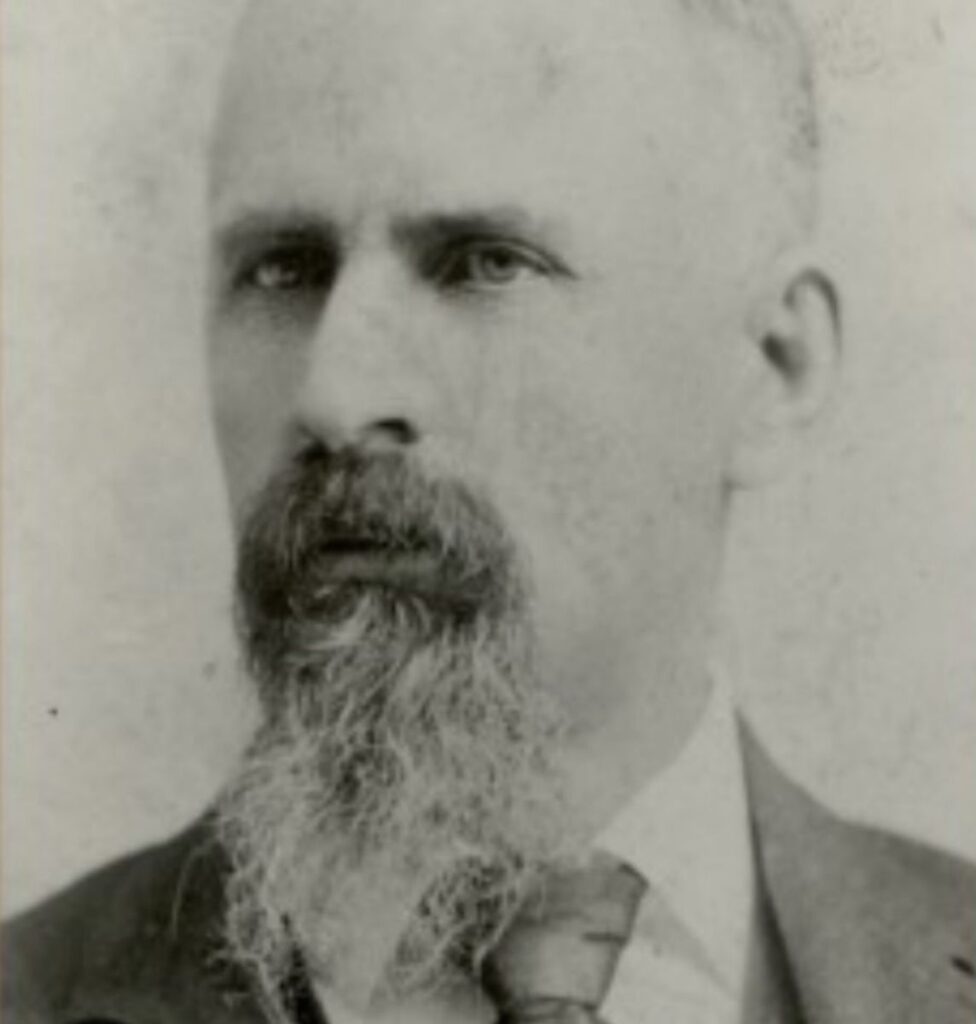
Born into a farming family in southern Christian County in 1847, James Forbes was the first to leave the farm and start his own business, a sawmill.
In 1872, his younger brother Madison joined him and Forbes & Bro. was born.
They continued to mill lumber but also started a wagon factory and soon had a general contracting business too.
The Great Fire
In 1882, both sets of brothers were on-site for the event that collectively made their careers: the Great Fire. This was the most devastating in a string of blazes that devoured downtown Hopkinsville during the late 19th century. Charles Meacham, a journalist who wrote a county history and also served as mayor, attributed the fire’s origins to a livery stable on South Virginia Street. It began in the evening of Oct. 25 and sprinted over to Main Street, then northward. It supposedly consumed nearly all the frame buildings downtown.

What sprung up from the ashes was a stronger city, a phoenix engineered by the Dalton and Forbes brothers. More fire-proof brick construction replaced frame. This is the downtown Hopkinsville we know today. Depending on your source, the city was rebuilt almost entirely by the Dalton Bros., or entirely by Forbes & Bro. I’m going to split the difference and say both are true.
A glance at the 1906 Sanborn map shows how much Forbes & Bro. had grown over the 44 years since its inception. Now Forbes Manufacturing, it offered hardware, wallpaper, paint, carriages, jewelry, china, plumbing, tobacco and barrels alongside their wooden products. It was a predecessor of modern box stores like Lowe’s and Home Depot. Their complex took up the entire block between 10th and 11th and South Virginia and Main streets and even bled into the block below.
The Forbes’ sash factory was almost certainly the point of origin for the windows in our house.
Kentucky Rehabilitation Tax Credit
The Kentucky’s Rehabilitation Tax Credit offers historic homeowners undertaking renovations a 30% tax credit on qualifying expenses. These include any repairs or maintenance to historic materials as well as updating systems.
Projects accepted into the program must follow the Secretary of the Interior’s Standards for Rehabilitation. In a nutshell, these are guidelines for updating historic buildings for modern use while being sensitive to historic materials and significance.
The Kentucky Rehabilitation Tax Credit gives a lot of lenience towards modernization. One area in which it is a real stickler, however, is historic windows.
Historic windows get a bad rap for being drafty and inefficient, symptoms of them not being well-maintained. Many owners of historic buildings don’t know how to fix or maintain their windows, are unsure where to even begin looking for a contractor who does, and are afraid of the price tag that would accompany the work. And most contractors would rather plug in new windows than do the tedious work required to restore old ones.
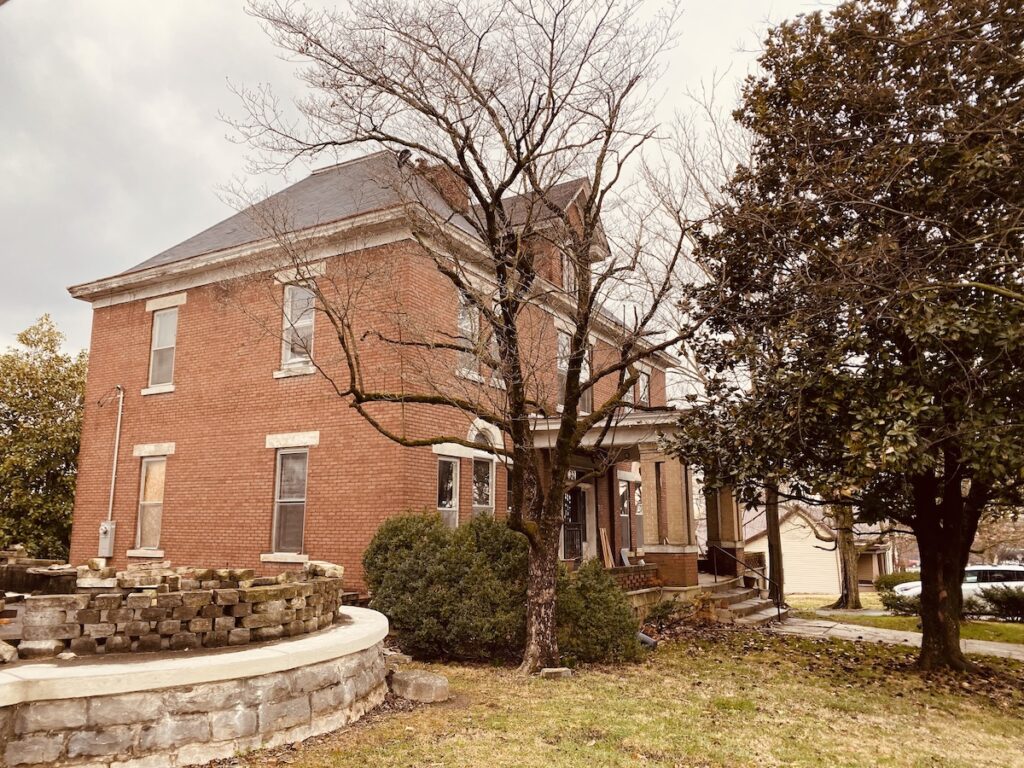
So historic windows inevitably get torn out and replaced with new ones. Once they’re gone, they’re usually gone forever.
The frequency of this story is why government grants and tax credits have in recent years put their foot down concerning historic windows. One of our conditions for receiving the state tax credit was that we restore, not replace, our historic windows. Little did they know, the fact that the Dalton house still had nearly all of its historic windows was one of its big selling points for us! The only windows that had been replaced were the two in the kitchen — the most ill-fitting and draftiest in the house.
The good news is that there’s no mystery to maintaining historic windows. Below is a quick and dirty guide I’ve put together for repairing and maintaining them.
But first, some history
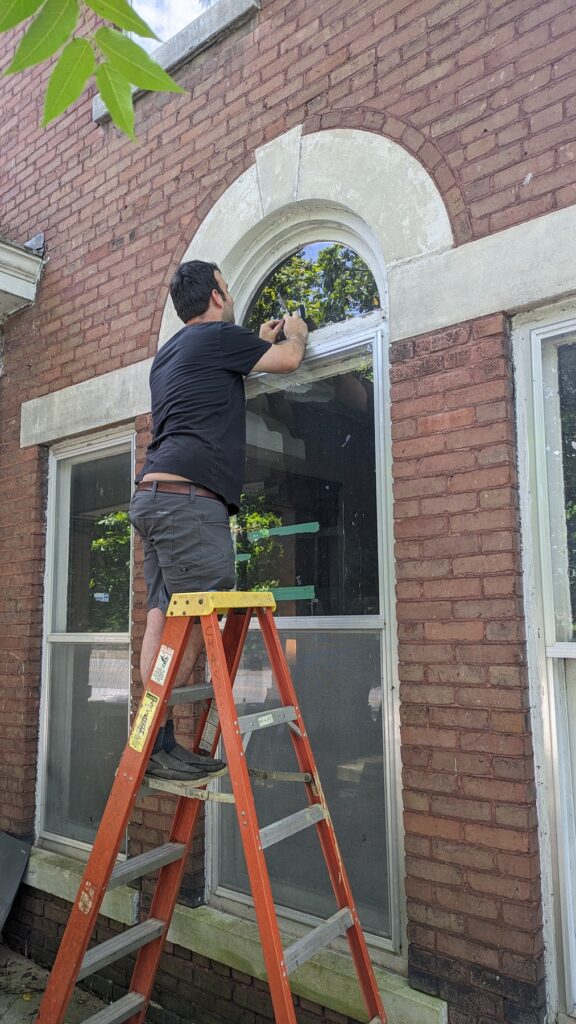
The typical historic window is made of a pair of sash, which are double-hung. There is a top sash and a bottom sash, and both can slide up and down.
The sliding window sash made its debut in North America in the early 1700s. Compartments concealed inside the window casings hide weights, which attach to the sash with cords or chains and allow the window sash to be raised and lowered effortlessly. The whole system is a machine.
The earliest sliding window sash were made up of many panes of glass, tied together by thin pieces of wood known as muntins (horizontal pieces) and mullions (vertical, structural pieces). Glass was a scarce commodity, and the technology to make it in large sheets did not exist until the mid-19th century.
Window sash containing a single pane of glass debuted on the market around 1890 and generally replaced multi-paned sash. Most of the windows in the Dalton house are single pane. The service areas, however, have windows with two panes, yet another indication of the hierarchy of spaces within the house.
Window woes
When we bought the Dalton house, we knew the windows needed a lot of work. Several, including one of the Palladian windows on the front of the house, were missing glass. Some of the windows had plexiglass in them. Others had the glass caulked in place. One of my favorite finds was a window that had the glass precariously taped in place with clear packing tape! Needless to say, we have had a lot of opportunities to practice working on historic windows.
Every historic homeowner can easily maintain their windows with just a little bit of knowledge and practice and (I’m not going to lie) a good dose of tedious work. I’m going to walk you through a repair we did to a large window in our bedroom.

A guide to repairing historic windows
We embarked on this repair after losing the glass to the major storm that wreaked havoc downtown on March 31, 2023. Before getting started, we removed the empty window sash and put plywood over the opening.
Finding materials and making repairs
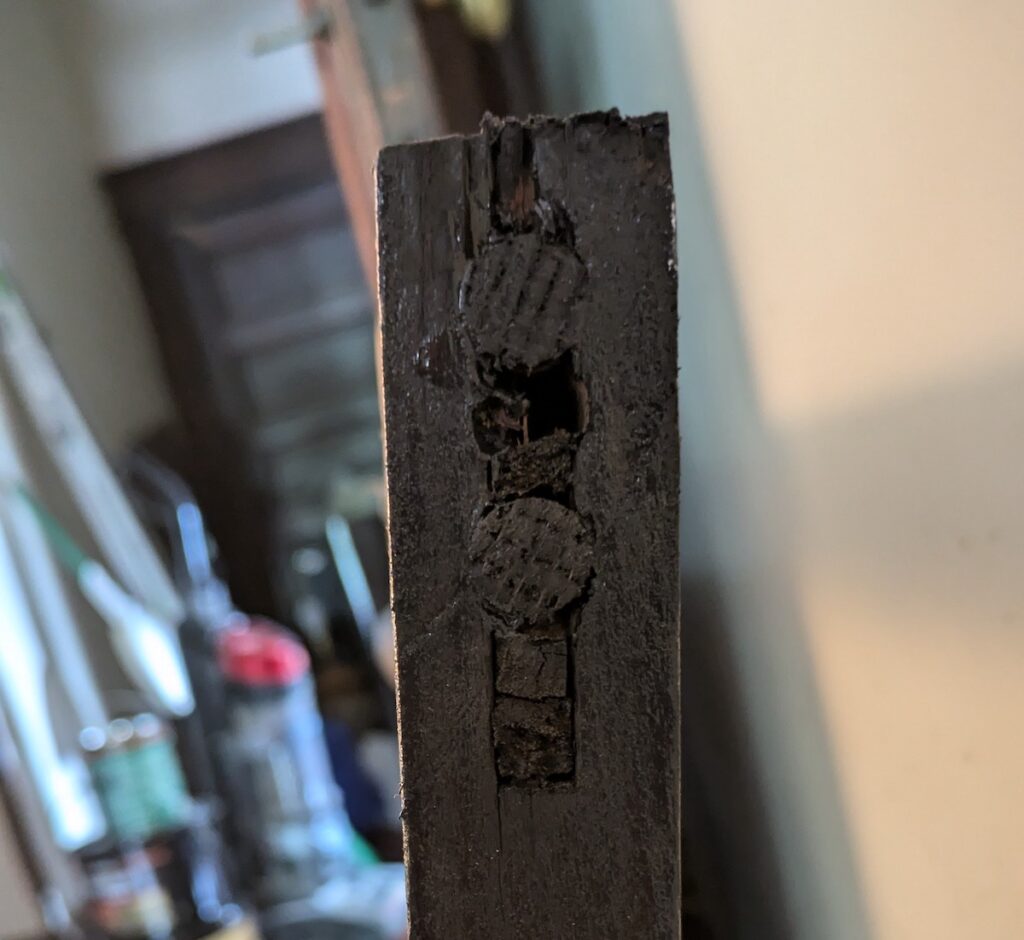
The most difficult part of this repair was finding a piece of glass big enough for the window. The largest sheet of glass stocked at Lowe’s was too small. After scavenging at Butler’s Antiques on Walnut Street, we found a window sash with an intact piece of glass that was big enough. At just $10, this was also less than half the price of a comparable piece of glass from Lowe’s.
A second problem was that the tenon that bound the bottom right corner of the sash together had rotted. Brendan cleaned out the rotten wood and pegged the joint with dowels.
Glazing and painting
Glazing and painting are the most common maintenance required for historic windows. We sanded both sides of the sash down to the wood, including the groove on the outside into which the glass fits, and primed the groove with oil paint. Glazing compound won’t adhere to bare wood.
Brendan cut the glass from the Butler’s sash down to the correct size and laid it into the groove. He secured it with glazing points, working them into the wood with a putty knife. The glazing points hold the glass in place. For a window this size, it’s good to insert a glazing point every 6 to 8 inches.
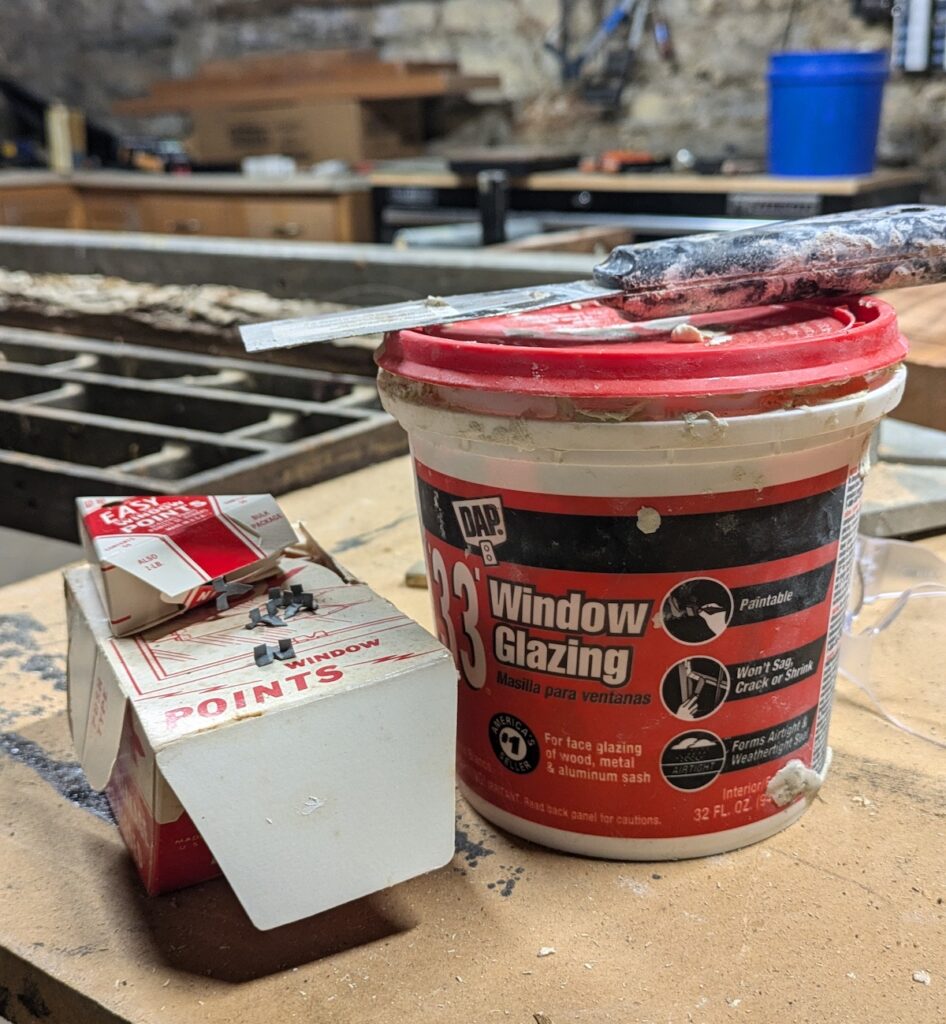
Glazing compound is an oil-based putty that fills the gaps between wood and glass. It plays an important role in making your window weatherproof. Reglazing historic windows is routine maintenance that needs to be done every few decades.
Every person who glazes windows has their own method. I was taught to roll a snake out of the glazing compound, lay it along the edge of the glass, and lightly jab it into place with my fingertips, filling crevices between the glass and wood.
Having done this down one whole edge, I run a putty knife flush with the face of the sash to cut away excess glazing compound off the top. Next, I place the knife at a 45-degree angle against the wood and glass and cut away excess glazing compound. This leaves behind a long triangle of glazing compound that fills the space between the edge of the glass and the wooden groove in which it fits. Finally, I run my finger along the glazing compound to smooth the surface.
After the glaze dried, which took months, we painted the exterior of the sash and the glazing with two coats of oil-based black paint. I always use oil-based paint on exterior woodwork because it penetrates the wood and repels water. Latex paint is more like a plastic stretched across a surface. It will repel water until it’s punctured, but then it traps water inside against the wood.
The inside of the window was painted with a dark gray latex paint. We stripped this and shellacked it, returning to the original finish. And this week, the window went back into its place. What a difference a window makes!
Maintaining historic windows
Aside from glazing and painting, historic windows need to be weather-stripped to help seal up any gaps and prevent drafts. Adding storm windows can really help with climate control. We currently have metal ones, which are functional but not too pretty. In the future, Brendan will gradually replace them with wooden storm windows, which should look like the actual window.
A final complaint many have is that the sash cords connecting the window weights have broken, making it nearly impossible to operate the windows correctly. The inside of the window weight compartment can actually be accessed in every historic window. Houses of different ages have varying systems. In ours, the compartment is sealed off by a piece of moulding, which can be removed. This moulding partially covers a screw. Once this is unscrewed, the piece of wood sealing up the compartment can be removed and the errant window weight retrieved. Hardware stores still sell sash cord.
The story of historic fabric
I’ve never seen a photograph of Henry Wahl, my second great-grandfather. I doubt he ever had one taken. But I like to think some of the window sash he made still exist and are being used — material testaments and records of his life.
Like all old materials, each historic window is an encyclopedia of the people who have worked on it. The story begins with the lumber workers and proceeds with the carpenters, glassmakers and transportation workers before the window sash ever even gets to the building where it will spend its life. Generations of glazers and painters follow.
Nearly none of these people’s names are recorded. Their work, encapsulated in a window sash, is the historical record for them. We can help ensure the story continues.
Grace Abernethy is a historic preservationist and artist who specializes in caring for and recreating historic architectural finishes. She earned her Master of Science in Historic Preservation from Clemson University in 2011 and has worked on historic buildings throughout the eastern United States. Abernethy was a recipient of the South Carolina Palmetto Trust for Historic Preservation Award in 2014 and won 2nd place in the Charles E. Peterson Prize for the Historic American Buildings Survey in 2011. She and her husband, Brendan, moved to Hopkinsville from Nashville in 2020. She works as an independent contractor and is a board member of the Hopkinsville History Foundation.


